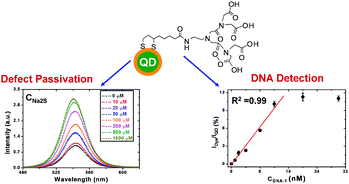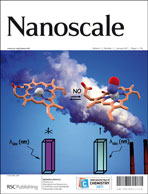Herein we report the synthesis of a new chelating dendritic ligand (CDL) and its use in the preparation a compact, stable and water-soluble quantum dot (QD), and further development of specific DNA sensor. The CDL, which contains a chelative dihydrolipoic acid moiety for strong QD surface anchoring and four dendritic carboxylic acid groups, provides a stable, compact and entangled hydrophilic coating around the QD that significantly increases the stability of the resulting water-soluble QD. A CDL-capped CdSe/ZnS core/shell QD (CDL-QD) has stronger fluorescence than that capped by a monodendate single-chain thiol, 3-mercapto-propionic acid (MPA-QD). In addition, the fluorescence of the CDL-QD can be enhanced by 2.5-fold by treatments with Zn2+ or S2− ions, presumably due to effective passivation of the surface defects. This level of fluorescence enhancement obtained for the CDL-QD is much greater than that for the MPA-QD. Further, by coupling a short single-stranded DNA target to the QD via the CDL carboxylic acid group, a functional QD-DNA conjugate that can resist non-specific adsorption and hybridize quickly to its complementary DNA probe has been obtained. This functional QD-DNA conjugate is suitable for specific quantification of short, labelled complementary probes at the low DNA probe:QD copy numbers via a QD-sensitised dye fluorescence resonance energy transfer (FRET) response with 500 pM sensitivity on a conventional fluorimeter.

You have access to this article
 Please wait while we load your content...
Something went wrong. Try again?
Please wait while we load your content...
Something went wrong. Try again?


 Please wait while we load your content...
Please wait while we load your content...